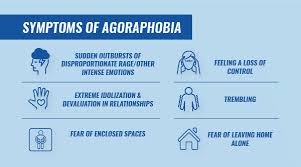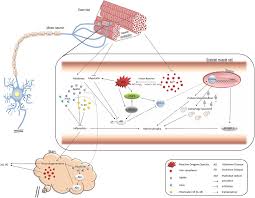 Health & Fitness
Health & Fitness
What Are the Causes, Symptoms, and Effective Treatments for…
Agoraphobia is a complex and often misunderstood anxiety disorder that affects millions of people worldwide. It is characterized by an intense fear of situations or places where escape might be difficult or help unavailable in the event of a panic attack. This fear can lead to avoidance behaviors, severely limiting a person’s ability to function in daily life. In this comprehensive guide, we will explore the causes, symptoms, and effective treatments for agoraphobia, providing valuable insights for those affected and their loved ones.
Understanding Agoraphobia
Agoraphobia is more than just a fear of open spaces. It is a multifaceted condition that often develops as a complication of panic disorder. People with agoraphobia fear situations where they might feel trapped, embarrassed, or unable to get help. Common triggers include crowded places, public transportation, enclosed spaces, or being outside the home alone.
The condition can range from mild to severe. In extreme cases, individuals may become housebound, unable to leave their safe environment without experiencing overwhelming anxiety. Understanding the root causes and recognizing the symptoms are crucial steps toward managing and overcoming agoraphobia.
Causes of Agoraphobia
The exact cause of Agoraphobia is not fully understood, but several factors contribute to its development. These include:
1. Genetic Predisposition
Research suggests that genetics play a role in anxiety disorders, including agoraphobia. If you have a family history of anxiety or panic disorders, you may be more susceptible to developing agoraphobia.
2. Brain Chemistry and Function
Imbalances in neurotransmitters, such as serotonin and dopamine, can contribute to anxiety disorders. Additionally, abnormalities in the amygdala, the brain region responsible for processing fear, may increase the likelihood of developing agoraphobia.
3. Traumatic Experiences
Trauma, such as childhood abuse, the death of a loved one, or a history of physical or emotional trauma, can trigger agoraphobia. These experiences may create a heightened sense of vulnerability and fear.
4. Panic Disorder
Agoraphobia often develops in individuals with panic disorder. The fear of experiencing another panic attack in a public or unfamiliar setting can lead to avoidance behaviors, which reinforce the phobia over time.
5. Environmental Factors
Stressful life events, such as divorce, job loss, or financial difficulties, can exacerbate anxiety and contribute to the development of agoraphobia.
Symptoms of Agoraphobia
Agoraphobia manifests through a combination of physical, emotional, and behavioral symptoms. Recognizing these signs is essential for early intervention and treatment.
Physical Symptoms
- Rapid heartbeat
- Shortness of breath
- Sweating or trembling
- Chest pain or discomfort
- Dizziness or lightheadedness
- Nausea or stomach upset
Emotional Symptoms
- Intense fear of losing control
- Fear of embarrassment or humiliation
- Feelings of detachment from reality
- Overwhelming anxiety in triggering situations
Behavioral Symptoms
- Avoidance of places or situations that trigger anxiety
- Dependence on a trusted companion to face feared situations
- Difficulty leaving the house or safe environment
- Social isolation and withdrawal
In severe cases, agoraphobia can lead to depression, substance abuse, and a significant decline in quality of life.
Diagnosing Agoraphobia
If you suspect that you or a loved one may have agoraphobia, it is important to seek professional help. A mental health professional, such as a psychologist or psychiatrist, can diagnose agoraphobia through a comprehensive evaluation.
The diagnostic process typically includes:
- Clinical Interview: The therapist will ask about your symptoms, medical history, and any traumatic experiences.
- Diagnostic Criteria: The diagnosis is based on the criteria outlined in the Diagnostic and Statistical Manual of Mental Disorders (DSM-5).
- Physical Examination: A doctor may perform a physical exam to rule out underlying medical conditions that could be causing the symptoms.
Effective Treatments
The good news is that agoraphobia is treatable. With the right combination of therapies and support, individuals can regain control of their lives. Here are some of the most effective treatments:
1. Cognitive Behavioral Therapy (CBT)
CBT is the gold standard for treating agoraphobia. This evidence-based therapy focuses on identifying and challenging negative thought patterns and behaviors. Through CBT, individuals learn to:
- Recognize and reframe irrational fears
- Develop coping strategies for managing anxiety
- Gradually face feared situations through exposure therapy
2. Exposure Therapy
Exposure therapy is a key component of CBT. It involves gradually and systematically exposing the individual to feared situations in a controlled and supportive environment. Over time, this helps reduce the fear response and build confidence.
3. Medication
In some cases, medication may be prescribed to manage symptoms. Common options include:
- Antidepressants: Selective serotonin reuptake inhibitors (SSRIs) and serotonin-norepinephrine reuptake inhibitors (SNRIs) are often used to treat anxiety disorders.
- Anti-Anxiety Medications: Benzodiazepines may be prescribed for short-term relief, but they are not recommended for long-term use due to the risk of dependence.
4. Relaxation Techniques
Practicing relaxation techniques, such as deep breathing, progressive muscle relaxation, and mindfulness meditation, can help reduce anxiety and promote a sense of calm.
5. Lifestyle Changes
Adopting a healthy lifestyle can support overall mental health. This includes:
- Regular exercise to reduce stress and improve mood
- A balanced diet rich in nutrients
- Adequate sleep to support emotional regulation
- Limiting caffeine and alcohol, which can exacerbate anxiety
6. Support Groups
Joining a support group can provide a sense of community and understanding. Sharing experiences with others who have similar challenges can be incredibly validating and empowering.
7. Self-Help Strategies
There are several self-help strategies that individuals can practice to manage agoraphobia:
- Educate yourself about the condition
- Set small, achievable goals for facing feared situations
- Celebrate progress, no matter how small
- Practice self-compassion and patience
Living with Agoraphobia: Tips for Coping
Living with agoraphobia can be challenging, but there are steps you can take to improve your quality of life:
- Build a Support Network: Surround yourself with understanding and supportive friends and family members.
- Create a Safe Space: Designate a calming and comfortable area in your home where you can retreat when feeling overwhelmed.
- Stay Connected: Use technology to stay connected with loved ones, even if you cannot leave the house.
- Seek Professional Help: Regular therapy sessions can provide ongoing support and guidance.
- Practice Self-Care: Prioritize activities that bring you joy and relaxation.
Conclusion
Agoraphobia is a challenging condition, but it is not insurmountable. By understanding the causes, recognizing the symptoms, and seeking effective treatment, individuals can take meaningful steps toward recovery. Whether through therapy, medication, or lifestyle changes, there is hope for a brighter, more fulfilling future.
If you or someone you know is struggling with agoraphobia, remember that help is available. Reach out to a mental health professional today and take the first step toward reclaiming your life.





